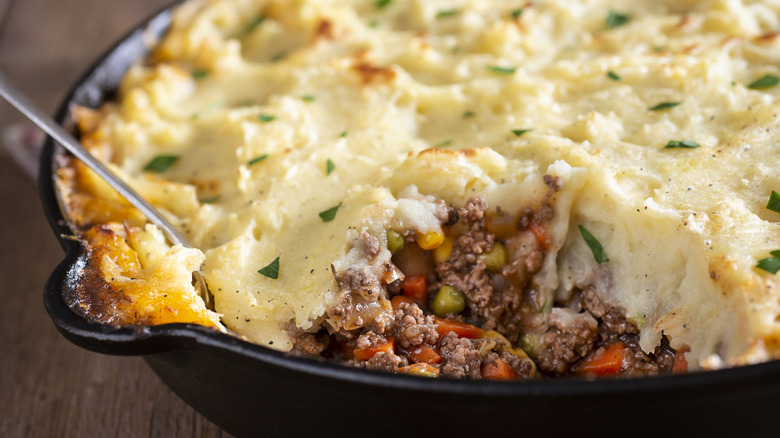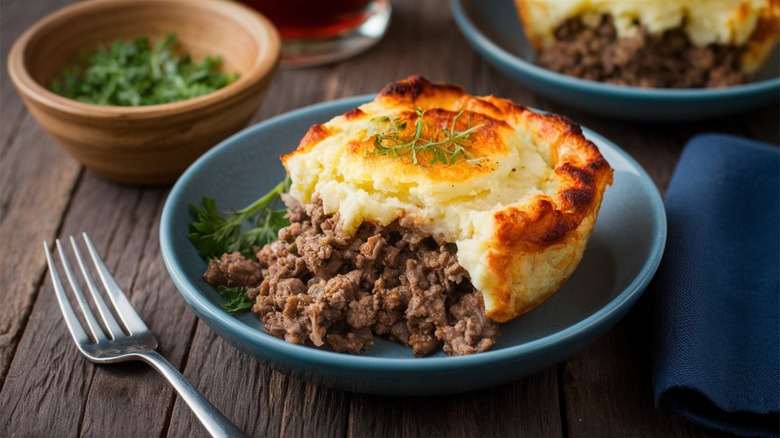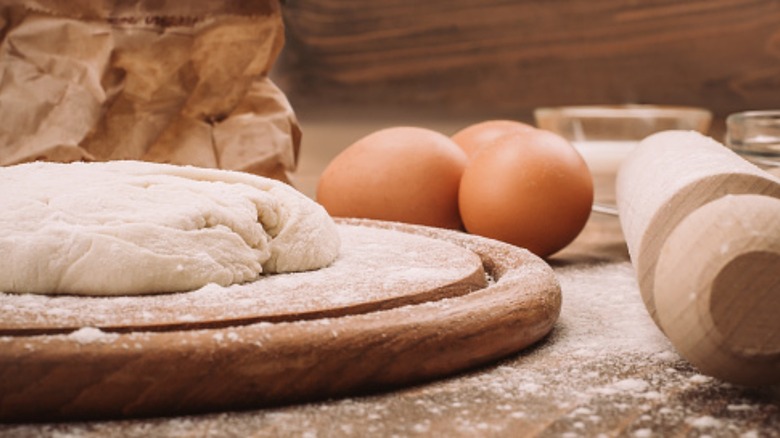Shepherd's Vs Cottage Pie: What's The Difference?
Leftovers got a big-time upgrade when some unknown soul in the British Isles in the 18th century decided to mince up yesterday's beef, and some mixed vegetables, and top the whole thing off with mashed potatoes. Whether the resulting dish is called shepherd's pie or cottage pie all depends on the meat. Otherwise, they're pretty much the same dish.
The original recipe, which used beef, was called cottage pie. The name was inspired by the cottages that the people of the Great Isle lived in at the time of the recipe's inception. This recipe is usually attributed to the English who were in a better position to eat beef, from a financial standpoint, than the Irish were. Recipes for cottage pie started cropping up in cookbooks in the 1700s. Frugal home cooks loved it because it gave them a delish and inexpensive way to use up the remnants of dinner beyond just tossing them back in the oven to warm them over.
Technically, shepherd's pie didn't roll onto the scene until the 19th century. Like cottage pie derived its name from the cottages that people lived in, shepherd's pie drew its naming inspiration from the shepherds — those of Irish or Scottish descent — who took care of the sheep and lambs that eventually became the roasted lamb meat that went into the version of the dish that became associated with the Irish.
Putting it together
Nowadays, people often use cottage and shepherd's pie interchangeably, which is understandable, given that the basic ingredients in each are the same: ground meat in some kind of gravy with vegetables. When making shepherd's pie at home, you'd typically start the dish by browning some ground lamb or mutton in an assortment of seasonings. For cottage pie makers, the meat of choice would be ground beef.
Once the meat is prepped, many cooks set the spuds on to boil, since you'll turn them into mashed potatoes later. In more ancient iterations of the dish, sliced potatoes were also used. Whatever style of spud you go with, just know that making a layer of potatoes in the bottom of the pan for the meaty casserole contents to sit on is also a thing. This puts the dish more in the territory of pot pie than a plain old casserole, given that the meat and vegetables are encased in the pastry from nearly all sides.
Finally, while you may have a great from-scratch shepherd's pie recipe, you're also free to follow tradition and make the casserole from your leftovers instead of starting with fresh, uncooked food. If you do this, keep in mind that you may need to adjust the seasoning levels, given that most, if not all, of the ingredients will have already been seasoned and cooked.
Other variations and components
In traditional recipes, shepherd's or cottage pie contained vegetables like carrots, onions, corn, and peas, though just about any vegetable could go into the dish since the original version of the recipes called for whatever cooked vegetable remnants were on hand. Regardless of the veggies and meat involved, all were mixed together with other ingredients such as tomato paste, Worcestershire sauce, rosemary, thyme, garlic, salt and pepper, and broth — beef, chicken, or otherwise.
Finally, some iterations of the dish don't include spuds at all. Instead, bread-loving cooks over the centuries have topped the pie with homemade dumplings or from-scratch biscuits (or canned in modern times). All of this is delicious, of course, made better only by the generous handfuls of cheddar or American cheese that seal the potato or dumpling crust off. That cheesy goodness is bound to make you glad that someone centuries ago figured out a better way to get rid of some leftovers than just reheating or tossing them.


